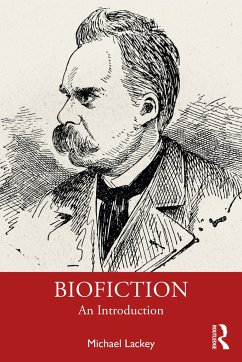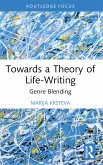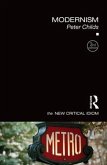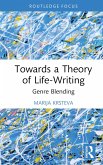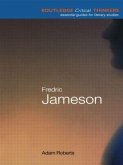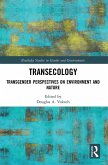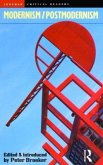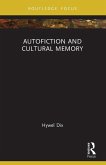- Broschiertes Buch
- Merkliste
- Auf die Merkliste
- Bewerten Bewerten
- Teilen
- Produkt teilen
- Produkterinnerung
- Produkterinnerung
Biofiction: An introduction provides readers with the history, origins, evolution, and legitimization of biofiction, suggesting potential lines of inquiry, exploring criticisms of the literary form, and modeling the process of analyzing and interpreting individual texts.
Andere Kunden interessierten sich auch für
![Towards a Theory of Life-Writing Towards a Theory of Life-Writing]() Marija KrstevaTowards a Theory of Life-Writing34,99 €
Marija KrstevaTowards a Theory of Life-Writing34,99 €![Modernism Modernism]() Peter Childs (UK Newman University College)Modernism23,99 €
Peter Childs (UK Newman University College)Modernism23,99 €![Towards a Theory of Life-Writing Towards a Theory of Life-Writing]() Marija KrstevaTowards a Theory of Life-Writing51,99 €
Marija KrstevaTowards a Theory of Life-Writing51,99 €![Fredric Jameson Fredric Jameson]() Adam RobertsFredric Jameson43,99 €
Adam RobertsFredric Jameson43,99 €![Transecology Transecology]() Transecology44,99 €
Transecology44,99 €![Modernism/Postmodernism Modernism/Postmodernism]() Peter BrookerModernism/Postmodernism83,99 €
Peter BrookerModernism/Postmodernism83,99 €![Autofiction and Cultural Memory Autofiction and Cultural Memory]() Hywel DixAutofiction and Cultural Memory22,99 €
Hywel DixAutofiction and Cultural Memory22,99 €-
-
-
Biofiction: An introduction provides readers with the history, origins, evolution, and legitimization of biofiction, suggesting potential lines of inquiry, exploring criticisms of the literary form, and modeling the process of analyzing and interpreting individual texts.
Hinweis: Dieser Artikel kann nur an eine deutsche Lieferadresse ausgeliefert werden.
Hinweis: Dieser Artikel kann nur an eine deutsche Lieferadresse ausgeliefert werden.
Produktdetails
- Produktdetails
- Verlag: Taylor & Francis Ltd
- Seitenzahl: 200
- Erscheinungstermin: 7. Juli 2021
- Englisch
- Abmessung: 229mm x 152mm x 11mm
- Gewicht: 302g
- ISBN-13: 9780367747633
- ISBN-10: 0367747634
- Artikelnr.: 61406865
- Herstellerkennzeichnung
- Libri GmbH
- Europaallee 1
- 36244 Bad Hersfeld
- gpsr@libri.de
- Verlag: Taylor & Francis Ltd
- Seitenzahl: 200
- Erscheinungstermin: 7. Juli 2021
- Englisch
- Abmessung: 229mm x 152mm x 11mm
- Gewicht: 302g
- ISBN-13: 9780367747633
- ISBN-10: 0367747634
- Artikelnr.: 61406865
- Herstellerkennzeichnung
- Libri GmbH
- Europaallee 1
- 36244 Bad Hersfeld
- gpsr@libri.de
Michael Lackey is Distinguished McKnight University Professor and Distinguished University Teaching Professor at the University of Minnesota, Morris. As a scholar of twentieth- and twenty-first-century intellectual, political, and literary history, he has authored and edited ten books, mostly about biofiction, including Truthful Fictions and Conversations with Biographical Novelists, which contain interviews with some of the world's most famous biographical novelists. He has also guest-edited many special issues about biofiction for journals like a/b: Auto/Biography Studies, Éire-Ireland: An Interdisciplinary Journal of Irish Studies, Mississippi Quarterly, and American Book Review.
Introduction I. The Nineteenth Century Origins 1. The Art of Agential
Living 2. Portraits of Whom? II. Literature, Cultural Critique, and
Political Liberation 3. Biofiction as Social Critique 4. The Irish, the
Unslave Trade, and the Decolonization of the Mind 5. The 1930s and the
First Surge in Biofiction III. Literary Debates 6. The Assault on
Biofiction 7. The William Styron Controversy 8. Postmodernism's
Historiographic Metafiction or Biofiction's "Truth" Proposals? 9. John
Edgar Wideman on the Ethics of Fictionalizing a Life in Biofiction IV. The
Uncanny Power of Biofiction 10. Biofiction as Cultural Intervention: The
Case of Sally Hemings 11. The 1990s: The Decade of Biofiction's Official
Legitimization and Dominance 12. The Transformative Powers of Biofiction
for Students: A Case Study of David Ebershoff's The Danish Girla
Acknowledgments
Introduction
I.
The Nineteenth Century Origins
1. The Art of Agential Living
2. Portraits of Whom?
Figure One
Figure Two
II.
Literature, Cultural Critique, and Political Liberation
3. Biofiction as Social Critique
4. The Irish, the Unslave Trade, and the Decolonization of the Mind
5. The 1930s and the First Surge in Biofiction
III.
Literary Debates
6. The Assault on Biofiction
7. The William Styron Controversy
8. Postmodernism's Historiographic Metafiction or Biofiction's "Truth"
Proposals?
9. John Edgar Wideman on the Ethics of Fictionalizing a Life in
Biofiction
IV.
The Uncanny Power of Biofiction
10. Biofiction as Cultural Intervention: The Case of Sally Hemings
11. The 1990s: The Decade of Biofiction's Official Legitimization and
Dominance
12. The Transformative Powers of Biofiction for Students: A Case Study of
David Ebershoff's The Danish Girl
Living 2. Portraits of Whom? II. Literature, Cultural Critique, and
Political Liberation 3. Biofiction as Social Critique 4. The Irish, the
Unslave Trade, and the Decolonization of the Mind 5. The 1930s and the
First Surge in Biofiction III. Literary Debates 6. The Assault on
Biofiction 7. The William Styron Controversy 8. Postmodernism's
Historiographic Metafiction or Biofiction's "Truth" Proposals? 9. John
Edgar Wideman on the Ethics of Fictionalizing a Life in Biofiction IV. The
Uncanny Power of Biofiction 10. Biofiction as Cultural Intervention: The
Case of Sally Hemings 11. The 1990s: The Decade of Biofiction's Official
Legitimization and Dominance 12. The Transformative Powers of Biofiction
for Students: A Case Study of David Ebershoff's The Danish Girla
Acknowledgments
Introduction
I.
The Nineteenth Century Origins
1. The Art of Agential Living
2. Portraits of Whom?
Figure One
Figure Two
II.
Literature, Cultural Critique, and Political Liberation
3. Biofiction as Social Critique
4. The Irish, the Unslave Trade, and the Decolonization of the Mind
5. The 1930s and the First Surge in Biofiction
III.
Literary Debates
6. The Assault on Biofiction
7. The William Styron Controversy
8. Postmodernism's Historiographic Metafiction or Biofiction's "Truth"
Proposals?
9. John Edgar Wideman on the Ethics of Fictionalizing a Life in
Biofiction
IV.
The Uncanny Power of Biofiction
10. Biofiction as Cultural Intervention: The Case of Sally Hemings
11. The 1990s: The Decade of Biofiction's Official Legitimization and
Dominance
12. The Transformative Powers of Biofiction for Students: A Case Study of
David Ebershoff's The Danish Girl
Introduction I. The Nineteenth Century Origins 1. The Art of Agential
Living 2. Portraits of Whom? II. Literature, Cultural Critique, and
Political Liberation 3. Biofiction as Social Critique 4. The Irish, the
Unslave Trade, and the Decolonization of the Mind 5. The 1930s and the
First Surge in Biofiction III. Literary Debates 6. The Assault on
Biofiction 7. The William Styron Controversy 8. Postmodernism's
Historiographic Metafiction or Biofiction's "Truth" Proposals? 9. John
Edgar Wideman on the Ethics of Fictionalizing a Life in Biofiction IV. The
Uncanny Power of Biofiction 10. Biofiction as Cultural Intervention: The
Case of Sally Hemings 11. The 1990s: The Decade of Biofiction's Official
Legitimization and Dominance 12. The Transformative Powers of Biofiction
for Students: A Case Study of David Ebershoff's The Danish Girla
Acknowledgments
Introduction
I.
The Nineteenth Century Origins
1. The Art of Agential Living
2. Portraits of Whom?
Figure One
Figure Two
II.
Literature, Cultural Critique, and Political Liberation
3. Biofiction as Social Critique
4. The Irish, the Unslave Trade, and the Decolonization of the Mind
5. The 1930s and the First Surge in Biofiction
III.
Literary Debates
6. The Assault on Biofiction
7. The William Styron Controversy
8. Postmodernism's Historiographic Metafiction or Biofiction's "Truth"
Proposals?
9. John Edgar Wideman on the Ethics of Fictionalizing a Life in
Biofiction
IV.
The Uncanny Power of Biofiction
10. Biofiction as Cultural Intervention: The Case of Sally Hemings
11. The 1990s: The Decade of Biofiction's Official Legitimization and
Dominance
12. The Transformative Powers of Biofiction for Students: A Case Study of
David Ebershoff's The Danish Girl
Living 2. Portraits of Whom? II. Literature, Cultural Critique, and
Political Liberation 3. Biofiction as Social Critique 4. The Irish, the
Unslave Trade, and the Decolonization of the Mind 5. The 1930s and the
First Surge in Biofiction III. Literary Debates 6. The Assault on
Biofiction 7. The William Styron Controversy 8. Postmodernism's
Historiographic Metafiction or Biofiction's "Truth" Proposals? 9. John
Edgar Wideman on the Ethics of Fictionalizing a Life in Biofiction IV. The
Uncanny Power of Biofiction 10. Biofiction as Cultural Intervention: The
Case of Sally Hemings 11. The 1990s: The Decade of Biofiction's Official
Legitimization and Dominance 12. The Transformative Powers of Biofiction
for Students: A Case Study of David Ebershoff's The Danish Girla
Acknowledgments
Introduction
I.
The Nineteenth Century Origins
1. The Art of Agential Living
2. Portraits of Whom?
Figure One
Figure Two
II.
Literature, Cultural Critique, and Political Liberation
3. Biofiction as Social Critique
4. The Irish, the Unslave Trade, and the Decolonization of the Mind
5. The 1930s and the First Surge in Biofiction
III.
Literary Debates
6. The Assault on Biofiction
7. The William Styron Controversy
8. Postmodernism's Historiographic Metafiction or Biofiction's "Truth"
Proposals?
9. John Edgar Wideman on the Ethics of Fictionalizing a Life in
Biofiction
IV.
The Uncanny Power of Biofiction
10. Biofiction as Cultural Intervention: The Case of Sally Hemings
11. The 1990s: The Decade of Biofiction's Official Legitimization and
Dominance
12. The Transformative Powers of Biofiction for Students: A Case Study of
David Ebershoff's The Danish Girl

